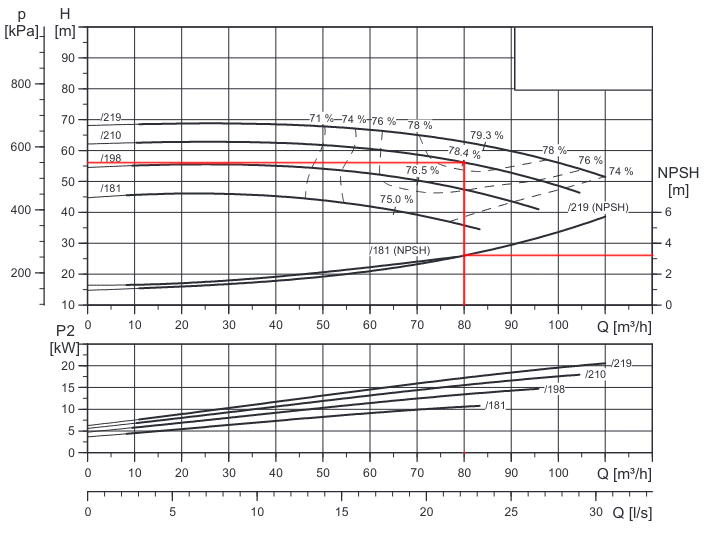Net positive suction head (NPSH)
What is pump cavitation
Cavitation in pumps is a real problem which shall be accounted for when designing a system whether closed or open. Cavitation occurs when the pressure on the suction side of the impellers in the pump get lower than the evaporation pressure i.e. the liquid is boiling even if the temperature is low. The boiling water will generate small steam bubbles and they will very quickly damage the pump.
How to avoid it
In closed systems there is several things that can be done to avoid this. The most simple one is to raise the pressure in the entire system. This also raises the pressure on the suction side of the impellers and consequently cavitation is less likely to occur. A similar solution is to lower the temperature at the inlet of the pump as this will raise the evaporation pressure. This can be hard to do but a different location in the system can sometime be the solution. Another way of avoiding cavitation is to install the pump lower in the system as the pump will benefit from the higher static pressure i.e. \( p = \rho gh \). Finally it can be necessary to source a pump with better cavitation characteristics.
The cavitation challenge is often bigger in open systems i.e. systems where the liquid is pumped from one source and discharged somewhere else. It only depends upon the static pressure do to height difference between liquid level at the source and the pump inlet, the pressure loss in the suction line and selecting the wrong pump.
Calculating available Net Positive Suction Head (NPSH)
Net positive suction head (NPSH) is a measure of the available pressure above the vapor pressure at the pump inlet and consequently is called available NPSH or NPSHa. The unit used is typically meter liquid column (mlc) or similar but can also be expressed in other units e.g. bar, Pa, psi etc. The equation is the same regardless of unit but make sure that the units match each other.
The friction loss in the suction pipe can be calculated using the procedure described on this page and the pressure loss in the straight parts of the suction pipe can be calculated using the Pipe Friction Loss Calculator.
The vapor pressure for water can be calculated using the water calculator.
Selecting the right pump
When selecting a pump for a given application it is important to look at the required NPSH (NPSHr) for the given pump. To avoid cavitation the available NPSH (NPSHa) shall be bigger than the required NPSHr from the pump i.e.
NPSHr for the pump is not a fixed value. It depends upon the flow rate and gets higher when the flow rate increases. See the graph in the example below.
A typical error when selecting a pump is to select a pump with a too high pressure at the selected duty point to have some extra margin. One example could be system requiring 80m3/hr and the required pressure head is calculated to be 3bar. The designer want some margin and selects a pump with a duty point of 80m3/hr at 4 bar. The result of this is a flow rate higher than the required 80m3/h, NPSHa will be lower as it depends upon the flow rate and to make matters worse the required NPSHr will be higher.
Signs of pump cavitation
It is important to be aware of signs of pump cavitation as cavitation in the pump will damage it because of the collapse of air bubbles. Some of the signs of pump cavitation is: - Noise from the pump - No suction i.e. low or no flow from the pump - Higher than normal number of revolutions
The noise originates from the bubbles i.e. steam generated because of the local pressure being below the vapor pressure and consequently the liquid is boiling. The bubbles will eventually collapse again when the pressure gets high enough. This collapse generates noise and if is happens on one of the surfaces in the pump (most likely the impeller itself) it will erode the surface and damage the pump. The no suction happens if it is a severe case of cavitation due to bubbles but the lack of suction can just as well be the reason why the pump is cavitating
Example
The sketch below show a simple example where the water source is below the pump. This could for example be a bilge pump onboard a ship. The suction pipe is very simple with two strait pipes and a 90degree bend. The pump is placed 2m above the surface of the liquid, friction loss in the suction pipe is calculated to 1.5mlc (see this article on how to calculate friction loss in pipes) and the evaporation pressure 0.43mlc (water at 30 degree C). Hd is typically low. In this example the flow velocity is 1.8m/s giving a dynamic pressure of 0.17mlc. The absolute pressure working on the surface of liquid is 10.3mlc
The pump shall deliver a total pressure of approximately 55mlc at 80m3/h. An example of a pump curve of a pump matching this is shown below. NPSHr at this flow rate is approximately 3.2mlc. This is well below the the available NPSH hence cavitation will not occur. Consider what will happen if the pressure head required on the pump discharge side is lower than expected. This will result in a higher flow rate, higher NPSHr and lower NPSHa because of higher friction loss in the suction pipe and suddenly cavitation might be a problem.
